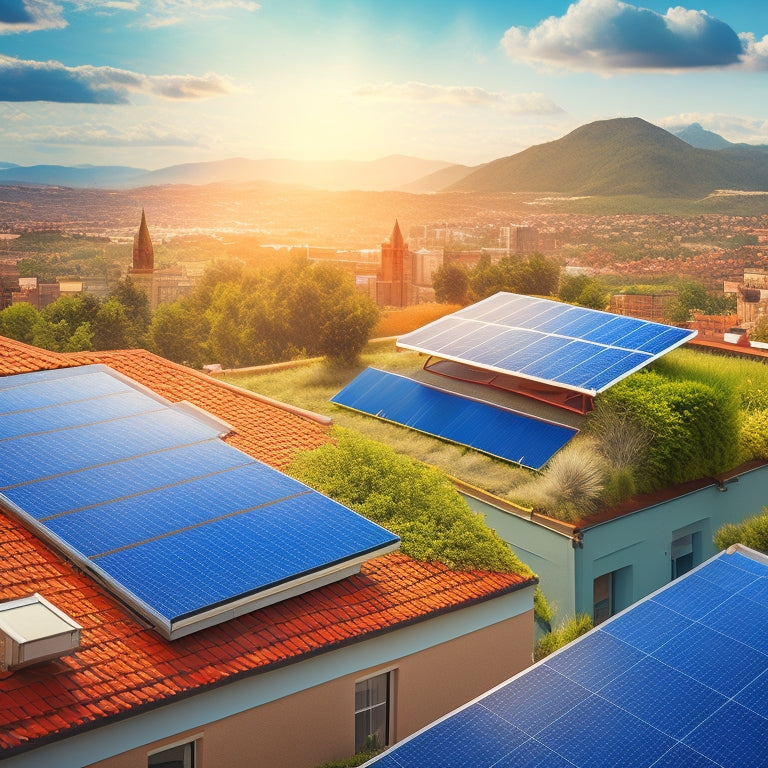
What Roofing Materials Best Protect Our Planet?
Share
As you consider the environmental impact of your building, you're likely to find that the roofing material you choose plays an essential role in reducing your carbon footprint and promoting sustainability. Cool roof technology, radiative cooling roof systems, and solar reflective roof coatings can lower energy consumption and minimize urban heat island effects. You can also opt for sustainable materials like green roofs, plant-based roofing, and low-carbon concrete roofs. Recycled metal roofing options, sustainable slate roofing choices, and energy-efficient roof insulation are also viable alternatives. By making an informed decision, you'll not only reduce your environmental impact but also uncover even more innovative solutions that benefit the planet.
Key Takeaways
- Solar reflective roof coatings and cool roof technology reduce urban heat islands, energy consumption, and carbon footprint.
- Green roofs with vegetation and plant-based roofing materials improve air quality, manage stormwater, and support urban sustainability.
- Recycled metal roofing options, sustainable slate, and eco-friendly clay tiles offer durable and recyclable solutions for environmentally friendly infrastructure.
- Energy-efficient roof insulation using thermal mass materials, solar power, and radiant barrier systems enhance building energy efficiency and comfort.
- Low-carbon construction materials like reduced-cement concrete roofs minimize greenhouse gas emissions, ensuring a longer lifespan and lower maintenance costs.
Solar Reflective Roof Coatings
Your roof is about to become a transformative element in the fight against climate change, thanks to solar reflective roof coatings.
These innovative materials can greatly reduce the urban heat island effect by reflecting solar energy instead of absorbing it. By doing so, they decrease the amount of heat that's transferred into your building, reducing the need for air conditioning and the resulting energy consumption.
As we reduce our reliance on the grid, solar reflective roof coatings can help minimize peak hour demand and enhance energy independence. This, in turn, lessens your building's environmental impact.
With solar reflective roof coatings, you can enjoy a cooler indoor climate while contributing to a more sustainable future. By utilizing the power of solar energy, you're taking a vital step towards reducing your carbon footprint and creating a better planet for generations to come.
Green Roofs for Urban Spaces
In conjunction with urban planning, green roofs for urban spaces are emerging as an essential component in the quest for sustainable development.
You're likely aware that urbanization leads to environmental degradation, but did you know that green roofs can mitigate this impact? By integrating vegetation into urban environments, you can enhance urban biodiversity and improve air quality.
Furthermore, green roofs provide effective stormwater management by reducing runoff and filtering rainwater. The use of renewable energy solutions, such as solar energy implementation, can further enhance the sustainability of urban spaces.
Additionally, green roofs can also help reduce reliance on fossil fuels, contributing to a cleaner, more sustainable transportation sector.
Some of the key benefits of green roofs include:
- Improved air quality through vegetation
- Enhanced urban biodiversity
- Reduced stormwater runoff and management
- Increased energy efficiency through insulation
Recycled Metal Roofing Options
As cities shift towards sustainable development, recycled metal roofing options emerge as an essential component in the quest for eco-friendly infrastructure. You're likely wondering how these materials stack up regarding durability and environmental impact. Let's break it down:
| Recycled Metal Option | Benefits |
|---|---|
| Aluminum | High recycled metal durability, 95% recyclable, reduces primary aluminum production energy by 95% |
| Copper | Excellent durability, 80% recyclable, reduces primary copper production energy by 85% |
| Steel | High recycled metal durability, 88% recyclable, reduces primary steel production energy by 74% |
| Zinc | Corrosion-resistant, 80% recyclable, reduces primary zinc production energy by 75% |
Energy-Efficient Roof Insulation
As you investigate energy-efficient roof insulation options, you'll want to evaluate the thermal mass benefits of materials like concrete and brick, which can absorb and release heat to regulate your building's temperature.
Additionally, incorporating solar power into your energy strategy can greatly reduce your reliance on the grid and lower energy bills, achieving energy independence and enhancing your brand reputation renewable energy solutions.
You'll also want to look into radiant barrier systems, which can reflect heat rather than absorb it, reducing cooling costs in warm climates.
Thermal Mass Benefits
Take control of your roof's energy efficiency by utilizing thermal mass benefits. This involves using materials with high thermal mass, such as concrete, brick, or stone, which can absorb and release heat slowly. This helps regulate your building's internal temperature, reducing the need for heating and cooling.
By tapping into renewable energy sources, you can further minimize your reliance on fossil fuels and lower your carbon footprint. Additionally, integrating solar roofing can reduce noise pollution, creating a quieter environment and contributing to a cleaner environment.
Thermal mass benefits include:
- Improved thermal performance, reducing energy consumption and greenhouse gas emissions
- Enhanced climate adaptability, as your building can respond to changing weather conditions
- Increased comfort, with a more stable and consistent indoor temperature
- Extended equipment lifespan, as HVAC systems work less hard to maintain a comfortable temperature
Radiant Barrier Systems
You can further optimize your roof's energy efficiency by incorporating radiant barrier systems, a type of energy-efficient roof insulation that reduces heat gain during summer and heat loss during winter.
These systems consist of reflective materials installed in attics or rafters, which block radiant heat transfer. When installed correctly, radiant barriers can reduce energy consumption by up to 12%.
In addition, integrating solar-powered charging solutions can also contribute to a more sustainable and eco-friendly approach to energy management.
Consideration of installation techniques is vital, as improper installation can lead to reduced effectiveness. Cost considerations are also important, as radiant barriers can be more expensive than traditional insulation materials.
However, the long-term energy savings and environmental benefits make them a worthwhile investment for eco-conscious homeowners.
Cool Roof Technology Benefits
By reflecting solar radiation and heat, cool roof technology benefits building owners and the environment alike.
You can reduce your energy consumption and carbon footprint by installing a cool roof. This technology is particularly effective in urban areas, where the urban heat island effect can increase temperatures by up to 10°F.
Some key benefits of cool roof technology include:
- Reduced energy costs from decreased cooling demands
- Extended roof lifespan due to reduced heat stress
- Improved air quality by reducing the urban heat island effect
- Enhanced occupant comfort and productivity
Eco-Friendly Clay Tile Roofs
While cool roof technology offers a range of benefits, another eco-friendly option gaining popularity is clay tile roofing.
You'll appreciate the durability comparison: clay tiles can last up to 50 years or more, making them a long-term solution for your home. Plus, they're resistant to extreme weather conditions, including high winds and hail.
When it comes to maintenance tips, keep in mind that clay tiles are relatively low-maintenance. You'll need to inspect them regularly for damaged or missing tiles, and clear debris from the roof to guarantee proper water flow.
With proper care, your clay tile roof won't only protect your home but also reduce your environmental impact.
Sustainable Slate Roofing Choices
Slate roofing has long been prized for its durability and fire-resistance, and sustainable slate roofing choices take these benefits to the next level.
You're not only getting a roof that can last for centuries, but you're also reducing your environmental impact. Sustainable slate roofing is all about responsible sourcing, ensuring that the extraction and production processes have minimal effects on the environment.
When choosing sustainable slate roofing, look for the following:
- Suppliers that adhere to environmentally responsible extraction methods
- Manufacturing processes that minimize waste and energy consumption
- Locally sourced materials to reduce transportation emissions
- Certifications like FSC or ISO 14001 that guarantee sustainable practices
Plant-Based Roofing Materials
Plant-based roofing materials, a revolutionary development in the industry, offer a unique blend of sustainability, durability, and eco-friendliness. You can now choose from a variety of innovative options that not only reduce your carbon footprint but also provide superior performance.
For instance, biodegradable shingles made from plant-based polymers or natural fibers like hemp can replace traditional asphalt shingles. Hemp roofing, in particular, is gaining popularity due to its exceptional durability, water resistance, and thermal insulation properties.
As you investigate plant-based roofing materials, you'll find that many are certified by organizations like the Forest Stewardship Council (FSC) or the International Organization for Standardization (ISO), ensuring that your eco-friendly choice also supports responsible forestry practices.
Low-Carbon Concrete Roofs
Cement-based concrete, a traditional roofing material, is getting a sustainable makeover with the development of low-carbon concrete roofs.
You can now opt for a more environmentally friendly alternative that reduces the environmental impact of traditional concrete. Low-carbon concrete roofs are made by reducing the amount of cement used, which is a significant contributor to greenhouse gas emissions.
Some benefits of low-carbon concrete roofs include:
- Reduced carbon footprint during production
- Improved durability analysis, ensuring a longer lifespan
- Lower maintenance costs due to increased resistance to weathering
- Compatibility with various roofing systems, making it a versatile option
Radiative Cooling Roof Systems
Investigate a revolutionary approach to roofing with radiative cooling roof systems, which exploit the power of the universe to cool your building.
These innovative systems work by emitting heat into space, rather than absorbing it from the sun. This process, known as radiative cooling, can reduce urban heat island effects and energy consumption.
By utilizing the natural temperature difference between the Earth and space, radiative cooling roof systems can maintain a cooler temperature without using electricity.
This sustainable solution can be especially beneficial in urban areas, where urban heat island effects can exacerbate heatwaves and air pollution.
Frequently Asked Questions
Can Roofing Materials Be Both Eco-Friendly and Budget-Friendly?
You're wondering if eco-friendly roofing materials have to break the bank. Think of it like buying a reusable water bottle - the initial investment pays off in the long run. Sustainable options like metal and recycled rubber roofs offer cost comparisons that'll make you feel liberated, with some even saving you up to 30% on energy bills.
How Do Natural Disasters Affect Eco-Friendly Roofing Materials?
When natural disasters strike, you'll want eco-friendly roofing materials that can withstand the impact. Look for materials with natural disaster resilience, sourced sustainably to minimize environmental harm, ensuring your roof not only protects you but also the planet.
Are There Roofing Materials Suitable for Historical Building Restorations?
When restoring historic buildings, you'll want to choose roofing materials that align with historic preservation goals and sustainable practices, such as clay tiles, slate, or metal roofs that mimic traditional designs while meeting modern environmental standards.
Can Eco-Friendly Roofing Materials Be Used for DIY Projects?
You can definitely opt for eco-friendly roofing materials in your DIY project, exploring sustainable options that reduce environmental impact. Consider materials like recycled rubber, solar tiles, or green roofs, which can be installed using DIY-friendly techniques and tools, giving you control over the process.
Do Eco-Friendly Roofing Materials Require Special Maintenance Procedures?
When you opt for eco-friendly roofing materials, you'll need to follow specific maintenance tips to guarantee they meet sustainability standards. You'll want to regularly inspect for debris, clean carefully, and apply protective coatings to extend their lifespan and maintain their eco-friendly benefits.
Related Posts
-

3 Sun-Powered Automated Shades for Energy-Savvy Homes
You're looking to change your home into an energy-savvy haven, and sun-powered automated shades are an essential step...
-

What Do Power Strips Do for Standby Energy?
You're likely aware that your devices, such as TVs and computers, continue to draw power even when turned off, a phen...
-

10 Eco-Friendly Air Management Tools for Clean Home Living
You're taking an essential step towards creating a healthier living space by seeking eco-friendly air management tool...


